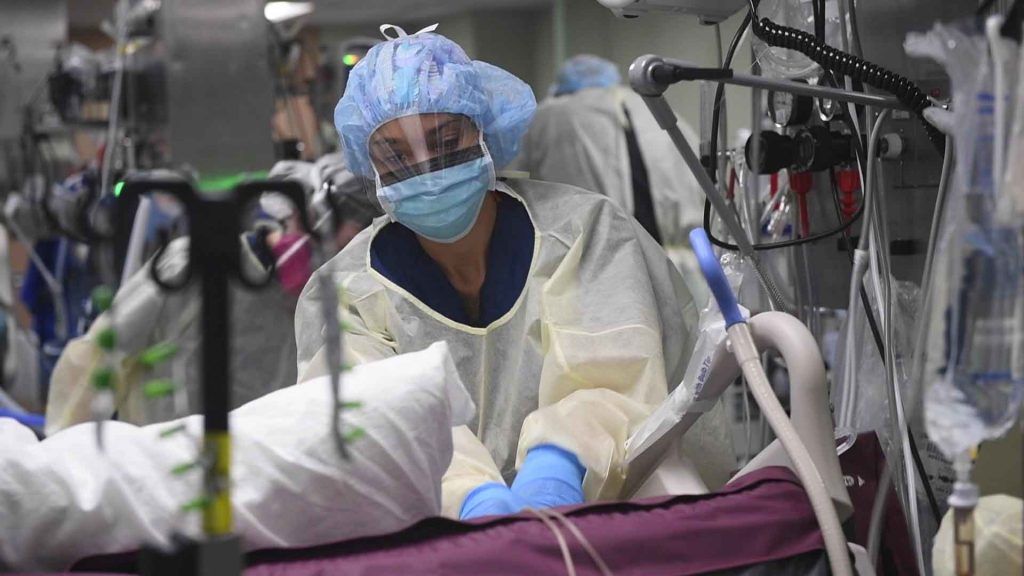US government expected to reveal its COVID-19 origins intelligence. Finally.
By Matt Field | June 22, 2023
 A nurse cares for a patient on a US Navy hospital ship during the COVID-19 pandemic. Credit: US Navy.
A nurse cares for a patient on a US Navy hospital ship during the COVID-19 pandemic. Credit: US Navy.
When President Joe Biden signed a law on March 20, he agreed to release declassified information on what US intelligence agencies had picked up in their hunt for the origins of COVID-19. The order came after the president had previously asked the agencies to assess whether the pandemic had its genesis in risky laboratory research on coronaviruses or in a spillover of the virus from animals to people. Those assessments came back with five agencies arguing, with low confidence, that the pandemic began with a spillover, two, with low or moderate confidence, concluding it had a lab origin, and one remaining non-committal to either theory.
Now the deadline has come and gone for the intelligence community to put its cards on the table and reveal more information about those findings, but instead of any official report, there have been only leaks.
First, The Wall Street Journal published an article on Tuesday naming three researchers at the Wuhan Institute of Virology who fell ill in November 2019, including a prominent bat coronavirus expert who had received funding from the US government. One of them could (some have speculated) have been patient zero in the pandemic.Then The New York Times came out with a preview of sorts of what the intelligence community had found. Among that article’s findings: The intelligence on the sick researchers didn’t sway agencies one way or another, and US intelligence officials seem doubtful the pandemic origins will ever be found.
According to the Journal, current and former US officials confirmed that Ben Hu, who worked on US funded studies on bat coronaviruses, and two other researchers—one being Yu Ping, who wrote that coronavirus research at the Wuhan Institute of Virology was done under relatively low biosafety precautions—got sick in November, when many experts agree the virus that causes COVID-19 likely first began to circulate in Wuhan. The Journal had previously reported there had been sick workers at the lab around the presumptive beginning of the pandemic, but not to this level of specificity.
The Journal said that US intelligence reports say that Hu, who had done “extensive” experimentation on how coronaviruses infected humans, had gotten sick with symptoms consistent with COVID-19 or a seasonal illness.
If there were three researches who had been working closely with bat coronaviruses and who got sick very early in the pandemic, many would presumably consider that compelling evidence for the so-called lab-leak theory for the origins of the pandemic—in part because their illnesses would seem to run counter to official pronouncements about the initial stages of the outbreak. After all, the first official COVID case, according to Chinese authorities, came on Dec. 8, 2019, after the lab workers reportedly fell ill. And previously, the World Health Organization (WHO), which produced a widely criticized investigation into the pandemic’s origins, reported that the staff under Shi Zhengli, a top coronavirus researcher at the Wuhan Institute of Virology, had all tested negative for SARS-CoV-2 antibodies. The Journal’s report on the three researchers relied on anonymous sources; the public has yet to see any specific information on Hu and the others that US spies may have as part of their origins review.
Still, it seems that US intelligence remains unable to wholeheartedly back either of the two major theories about the origin of the COVID pandemic. “Intelligence agencies view the information about the cases neutrally, arguing that they do not buttress the case for the lab leak or for natural transmission, according to officials briefed on the intelligence,” Times reporter Julian Barnes wrote in an article published Wednesday.
Barnes’s article said there is “no smoking gun” to be found in the presumably forthcoming documentation of US intelligence agency efforts. Whatever is in those reports, as Times columnist Zeynep Tufekci noted Wednesday, the administration is already late in revealing it. The 90-day clock stopped Sunday. The Biden administration needs “to quickly declassify as much as possible of what it knows about the pandemic’s origins,” she wrote. “In addition, the National Institutes of Health, which reportedly funded some of the research in China under scrutiny, needs to be forthcoming too, rather than waiting for more leaks or laws forcing its hand.
“When people lose trust in institutions, misinformation appears more credible. The antidote is more transparency and accountability.”
Together, we make the world safer.
The Bulletin elevates expert voices above the noise. But as an independent nonprofit organization, our operations depend on the support of readers like you. Help us continue to deliver quality journalism that holds leaders accountable. Your support of our work at any level is important. In return, we promise our coverage will be understandable, influential, vigilant, solution-oriented, and fair-minded. Together we can make a difference.
Keywords: COVID-19
Topics: Biosecurity














